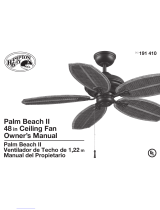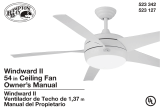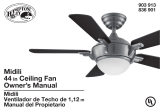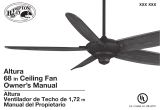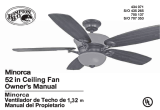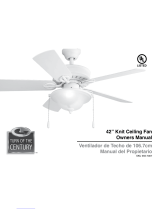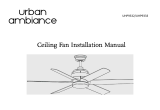Page is loading ...

523 342
523 127
Windward II
54 in Ceiling Fan
Owner’s Manual
Windward II
Ventilador de Techo de 1,37 m
Manual del Propietario
150 mm
213 mm
The spot color is for reference proof only, please follow
pantone guide for actual color when printing.
This line is for die-cut position only
DO NOT PRINT IT!!!
Black Magenta Yellow Black PMS 465C PMS 5425C PMS 632C Die
Total Colors
1C
Coating
Varnish
ADDITIONAL INFORMATION
V0.0
10-01-15
V1.3
09-07-29
V0.0
17 Apr 09
V0.0
17 Apr 09
V0.0
17 Apr 09
V0.0
17 Apr 09
V0.0
17 Apr 09
V0.0
17 Apr 09
V0.0
17 Apr 09
V0.0
17 Apr 09
V0.0
17 Apr 09
V0.0
17 Apr 09
V0.0
17 Apr 09
V0.0
17 Apr 09
V0.0
17 Apr 09
V0.0
17 Apr 09
V0.0
17 Apr 09
1. UPC at 100% and without truncated.
2. The smallest fonts size is 6 points in the artwork.
File Name:
Artwork Version:
Customer:
Buyer:
Sold In Country:
Item Number:
Catergory:
MVendor:
Printing Type:
Translation Agency:
Size:
Blank Size:
Artist:
C.S.:
Date:
HD_014842A_523342_MC
V0.0
Home Depot
TBA
US
N/A
Ceiling Fan
KOF
Offest
TBA
213(L) x 150(W) mm
213(L) x 150(W) mm
Johnny
Chris Que
10-01-15

54” Windward II
Ceiling Fan by Hampton Bay
(1) 30-Watt Pin-Based
Circular Bulb Included
3-Speed Reverse Function for
Year-Round Comfort and Savings
ENERGY STAR Certied
Tri-Mount Installation
QUESTIONS, PROBLEMS, MISSING PARTS:
Before returning to your local Home Depot, please call our
Customer Service Team at 1-877-527-0313 or visit www.homedepot.com.
Please reference your SKU (523 342 white, 523 127 brushed steel)
or UPC (082392 552961 white, 082392 552954 brushed steel).
Thank you for purchasing this Hampton Bay ceiling
fan. This product has been manufactured with the
highest standards of safety and quality. The nish
of this fan is weather resistant, but over time will
naturally weather and fade.
Safety Rules ........................................1
Unpacking Your Fan .......................... 2
Installing Your Fan ............................ 3
Operating Your Fan ........................... 11
Operating Your Remote Control ......12
Care of Your Fan ................................14
Troubleshooting ..................................14
Specications ......................................15
Warranty Information .......................16
Table of Contents
UL Model No. 54-WWD

Safety Rules ........................................1
Unpacking Your Fan .......................... 2
Installing Your Fan ............................ 3
Operating Your Fan ........................... 11
Operating Your Remote Control ......12
Care of Your Fan ................................14
Troubleshooting ..................................14
Specications ......................................15
Warranty Information .......................16
1. To reduce the risk of electric shock, insure electricity
has been turned off at the circuit breaker or fuse box
before beginning.
2. All wiring must be in accordance with the National
Electrical Code ANSI/NFPA 70-1999 and local electrical
codes. Electrical installation should be performed by a
qualied licensed electrician.
3. WARNING: To reduce the risk of re or electric shock,
this fan should only be used with fan speed control part no.
UC7058RYK, manufactured by Rhine Electronic Co., Ltd.
or part no.: FAN-10R, manufactured by Chia Wei Electric
Co., Ltd.
4. WARNING: To reduce the risk of shock, this fan must be
installed with an isolation wall control/switch.
5. CAUTION: To reduce the risk of personal injury, use only
the screws provided with the outlet box.
6. The outlet box and support structure must be securely
mounted and capable of reliably supporting a minimum of
35 pounds. Use only UL Listed outlet boxes marked “FOR
FAN SUPPORT.”
7. The fan must be mounted with a minimum of 7 feet
clearance from the trailing edge of the blades to the oor.
8. Do not wait for the fan to stop to press the reverse button.
The fan will not reverse if the fan is not moving.
9. Avoid placing objects in path of the blades.
10. To avoid personal injury or damage to the fan and
other items, be cautious when working around or
cleaning the fan.
11. Do not use water or detergents when cleaning the fan or fan
blades. A dry dust cloth or lightly dampened cloth will be
suitable for most cleaning.
12. After making electrical connections, spliced conductors
should be turned upward and pushed carefully up into
outlet box. The wires should be spread apart with the
grounded conductor and the equipment-grounding
conductor on one side of the outlet box.
13. Electrical diagrams are for reference only. Light kits that are
not packed with the fan must be UL Listed and marked suit-
able for use with the model fan you are installing.
14. WARNING: To reduce risk of re or electric shock, do not
use this fan with any solid-state speed control device.
15. All set screws must be checked and retightened where nec-
essary before installation.
Safety Rules 1.
READ AND SAVE THESE INSTRUCTIONS
TO REDUCE THE RISK OF FIRE, ELECTRIC SHOCK OR PERSONAL
INJURY, MOUNT TO OUTLET BOX MARKED “ACCEPTABLE FOR
FAN SUPPORT OF 35LBS (15.9KG) OR LESS” AND USE MOUNTING
SCREWS PROVIDED WITH THE OUTLET BOX. OUTLET BOXES COM-
MONLY USED FOR THE SUPPORT OF LIGHTING FIXTURES ARE NOT
ACCEPTABLE FOR FAN SUPPORT AND MAY NEED TO BE REPLACED.
CONSULT A QUALIFIED ELECTRICIAN IF IN DOUBT.
TO REDUCE THE RISK OF PERSONAL INJURY, DO NOT BEND THE
BLADE BRACKETS (ALSO REFERRED TO AS (“FLANGES”) DURING
ASSEMBLY OR AFTER INSTALLATION. DO NOT INSERT OBJECTS IN
THE PATH OF THE BLADES.

a. Blade Attachment Hardware
(16 Screws)
b. Electrical Hardware
(3 plastic wire connectors, 1 Clevis pin,
1 bolt)
c. Close-To-Ceiling Mount Hardware
(1 rubber gasket)
d. Blade Balancing Kit
7. Glass Shade
8. Blades (5)
9. Remote Batteries
10. Remote Control Hand Unit & Wall Mount
11. Circline Fluorescent Lamp
1. Slide-On Mounting Plate (inside Canopy)
2. Downrod and Ball Assembly
3. Canopy with Canopy Ring Attached
4. Decorative Motor Collar Cover
5. Fan Motor Assembly
6. Light Kit Fitter Assembly
2. Unpacking Your Fan
IMPORTANT: THIS PRODUCT AND/OR COMPONENTS ARE COVERED BY
ONE OR MORE OF THE FOLLOWING U.S. PATENTS: 5,947,436; 5,988,580;
5,971,573; 6,010,110; 6,010,306; 6,039,541; 6,046,416 AND OTHER
PATENTS PENDING.
Unpack your fan and check the contents. You should have the following items:
4.
3.
2.
1.
7.
6.
5.
8.
11.
10.
9.
c
a b
d
c
a b
d

Installing Your Fan 3.
Tools Required
Phillips screw driver, straight slot screw
driver, adjustable wrench, step ladder, and
wire cutters.
Mounting Options
If there isn’t an existing outlet box, then read
the following instructions. Disconnect the
power by removing fuses or turning off
circuit breakers.
Secure the outlet box directly to the building
structure. Use appropriate fasteners and
building materials. The outlet box and its
support must be able to fully support the
moving weight of the fan (at least 35 lbs.)
Do not use plastic outlet boxes.
Figures 1, 2, and 3 are examples of different
ways to mount the outlet box.
Note: You may need a longer downrod to
maintain proper blade clearance when install-
ing on a steep, sloped ceiling. The maximum
angle allowable is 30˚. If the canopy touches
downrod, remove the decorative canopy
bottom cover and turn the canopy 180˚ before
attaching the canopy to the mounting plate.
To hang your fan where there is an existing
xture but no ceiling joist, you may need an
installation hanger bar as shown in Figure 4
(available at your Hampton Bay retailer).
TO REDUCE THE RISK OF FIRE, ELECTRIC
SHOCK OR PERSONAL INJURY, MOUNT
FAN ONLY TO AN OUTLET BOX MARKED
ACCEPTABLE FOR FAN SUPPORT AND
USE THE MOUNTING SCREWS PROVIDED
WITH THE OUTLET BOX. OUTLET BOXES
COMMONLY USED FOR THE SUPPORT
OF LIGHTING FIXTURES MAY NOT BE
ACCEPTABLE FOR FAN SUPPORT AND
MAY NEED TO BE REPLACED. CONSULT A
QUALIFIED ELECTRICIAN IF IN DOUBT.
Figure 1
Figure 2
Figure 4
Figure 3

2. Remove the mounting plate from the
canopy by loosening the four screws on
the top of the canopy. Remove the two
non-slotted screws and loosen the slotted
screws. This will enable you to remove the
mounting plate (Figure 6).
4.
Hanging the Fan
REMEMBER to turn off the pow-
er. Follow the steps below to hang your
fan properly.
NOTE: This ceiling fan is supplied with two
types of hanging assemblies; the standard
ceiling installation using the downrod with
ball and socket mounting, and the “close-to-
ceiling” mounting. The “close-to-ceiling”
mounting is recommended in rooms with
less than 8-foot ceilings or in areas where
additional space is desired from the oor
to the fan blades. When using standard
downrod installation, the distance from the
ceiling to the bottom of the fan blades will be
approximately 12 inches. The “close-to-ceiling”
installation reduces the distance from the
ceiling to the bottom of the fan blades to
approximately 8 inches.
Once you have decided which ceiling
installation you will use, proceed with the
following instructions. Where necessary,
each section of the instructions will note the
different procedures to follow for the two
types of installation.
Standard Ceiling Mounting
1. Remove the canopy ring from the canopy
by turning the ring to the right until it
unlocks (Figure 5).
Figure 5
Figure 6 Figure 7
3. Route the wires exiting the top of the
fan motor through the decorative motor
collar cover then the canopy ring. Make sure
the slot openings are on top. Route the wires
through the canopy and then through the
ball/downrod assembly (Figure 7).
4. Loosen, but do not remove, the set
screws on the collar on the top of the
motor housing.
5. Align the holes at the bottom of the
downrod with the holes in the collar
on top of the motor housing (Figure 7).
Carefully insert the bolt through the
holes in the collar and downrod. Be
careful not to jam the bolt against the
wiring inside the downrod. Insert the

5.
Figure 8
Figure 9 Figure 10
Figure 11
Clevis pin through the hole near the
end of the bolt until it snaps into its
locked position, as noted in the circle inset
of Figure 7.
6. Re-tighten the set screws on the collar on top
of the motor housing (Figure 8).
7. Proceed to “Installing the Fan” section.
FAILURE TO PROPERLY INSTALL CLEVIS PIN
AS NOTED IN STEP 5 COULD RESULT IN FAN
LOOSENING AND POSSIBLY FALLING.
FAILURE TO COMPLETELY TIGHTEN THE
THREE SCREWS IN STEP 7 COULD RESULT IN
FAN LOOSENING AND POSSIBLY FALLING.
WHEN USING THE STANDARD BALL/DOWNROD
MOUNTING, THE TAB IN THE RING AT THE BOT-
TOM OF THE MOUNTING PLATE MUST REST IN
THE GROOVE OF THE HANGER BALL. FAILURE
TO PROPERLY SEAT THE TAB IN THE GROOVE
COULD CAUSE DAMAGE TO WIRING.
Tighten Set
Screw
“Close-to-Ceiling” Mounting
1. Remove canopy ring from the canopy by
turning the ring to the right until it unlocks
(Figure 5).
2. Remove the mounting plate from the canopy
by loosening the four screws on the top of the
canopy. Remove the two non-slotted screws
and loosen the slotted screws. This will enable
you to remove the mounting plate (Figure 6).
3. Remove the decorative canopy bottom cov-
er from the canopy by depressing the three
studs (Figure 9).
4. Remove three of the six screws and lock
washers (every other one) securing the mo-
tor collar to the top of the fan motor housing
(Figure 10).
5. Place the rubber gasket over the
remaining three screws, route the wires
exiting the top of the fan motor through the
canopy ring (make sure the slot openings
are on top), then proceed to place the ceiling
canopy over the collar at the top of the motor
(Figure 11).
6. Align the mounting holes with the holes
in the motor and fasten, using the three
screws and lock-washers removed in
step 4 (Figure 11).
7. Tighten the mounting screws securely.

6.
Setting the Dip Switches In
the Receiver:
In the transmitter, the dip switches are
accessible from the battery compartment
as shown in Figure A. The dip switches in
the receiver are located on top of the fan
motor assembly as shown in Figure B. The
dip switches are accessible through the top
of the motor assembly. Set the switches in
the same position as the switches in the
transmitter. After the dip switch positions
have been changed and you have assured
that they match the settings in the transmit-
ter, turn the power on and test.
Make sure the dip switches setting in the
transmitter match the receiver.
When two or more fans are located near
each other you may want to have each set
to a different frequency so that operation
of one fan will not interfere with the other.
This can be done by changing the ON/OFF
position of any one or more of a group of 4
dip switches grouped together in the trans-
mitter. The receiver, located on the top of
the fan motor assembly, has a similar set of
dip switches which must also be changed
to match the transmitter settings. Because
the dip switches are small, please use a ne
point instrument to adjust the settings.
21 34
ON ECE
Transmitter
Battery
Compartment
Dip Switches
2134
ON ECE
Optional
Figure A
Figure B

7.
Installing Fan to
the Outlet Box
1. Pass the 120-volt supply wires through the
center hole in the ceiling mounting plate as
shown in Figure 7.
2. Install the ceiling mounting plate on the
outlet box, by sliding the mounting plate
over the two screws provided with the outlet
box (Figure 7). When using close-to-ceiling
mounting, it is important that the mount-
ing plate be level. If necessary, use leveling
washers (not included) between the mount-
ing plate and the outlet box. Note that the
at side of the mounting plate is toward the
outlet box (Figure 7).
3. Securely tighten the two mounting screws.
4. Carefully lift the assembly up to the ceil-
ing mounting plate. If using close-to-ceil-
ing mounting, hang the fan on the hook
provided by utilizing one of the holes at
the outer rim of the ceiling canopy (Fig-
ure 12). If using standard mounting, seat
the hanger ball in the mounting plate
socket. Make sure the tab on the mount-
ing plate socket is properly seated in
the groove in the hanger ball.
Figure 12
WHEN MOUNTING THE FAN ON A SLOPED
CEILING, THE STANDARD BALL/DOWNROD
MOUNTING METHOD MUST BE USED. THE
MOUNTING PLATE MUST BE MOUNTED SO
THAT THE SLOT OPENINGS ARE ON THE
LOWER SIDE BY SLIDING THE MOUNTING
PLATE FROM THE TOP DOWN.
THE HOOK AS SHOWN IN FIGURE 12 IS ONLY
TO BALANCE FAN WHILE ATTACHING WIRING.
FAILURE TO HANG AS SHOWN IN FIGURE 12
MAY RESULT IN HOOK BREAKING, CAUSING
THE FAN TO FALL. HOOK MUST PASS FROM
INSIDE TO OUTSIDE OF CANOPY.

8.
White
White
Blue
Black
Fan Motor
Housing
Light Kit Assembly
Ground
Conductor
Black
White
Green
Black
White
SUPPLY CIRCUIT
Green Ground Lead
Ground to Downrod
Diagram indicates light kit wiring
Making the Electrical
Connections
REMEMBER to disconnect the power. If
you feel you do not have enough electrical
wiring knowledge or experience, have your fan
installed by a licensed electrician.
Follow the steps below to connect the fan
to your household wiring. Use the wire
connecting nuts supplied with your fan. Se-
cure the connectors with electrical tape.
Make sure there are no loose strands or
connections.
Step 1 Connect the fan supply (black) wire to
the black household supply wire as shown in
Figure 13.
Step 2 Connect the neutral fan (white) wire to
the white neutral household wire.
Step 3 Connect the two green fan ground wires,
located on the downrod and mounting bracket,
to the household ground wire. When using
Close-to-Ceiling mounting, there is only one
green ground wire from the ceiling mounting
bracket since the ball/downrod assembly not
used.
EACH WIRE NUT (WIRE CONNECTOR) SUP-
PLIED WITH THIS FAN IS DESIGNED TO ACCEPT
UP TO ONE 12 GAUGE HOUSE WIRE AND TWO
WIRES FROM THE FAN. IF YOU HAVE LARGER
THAN 12 GAUGE HOUSE WIRING OR MORE
THAN ONE HOUSE WIRE TO CONNECT TO THE
FAN WIRING, CONSULT AN ELECTRICIAN FOR
THE PROPER SIZE WIRE NUTS TO USE.
TO REDUCE RISK OF FIRE OR ELECTRIC
SHOCK, DO NOT USE A WALL MOUNTED SOLID
STATE SPEED CONTROL WITH THIS FAN. IT
WILL PERMANENTLY DAMAGE THE ELECTRONIC
CIRCUITRY.
Step 4 After connecting the wires, spread them
apart so that the green and white wires are on
one side of the outlet box and the black wire is
on the other side.
Step 5 Turn the wire connecting nuts upward
and push the wiring into the outlet box.
Figure 13

9.
Finishing the Fan
Installation
STANDARD CEILING MOUNTING
1. Align the locking slots of the ceiling canopy
with the two screws in the mounting plate.
Push up to engage the slots and turn clock-
wise to lock in place. Immediately tighten
the two mounting screws rmly.
2. Install the remaining two mounting
screws into the holes in the canopy and
tighten rmly.
3. Install the decorative canopy ring by
aligning the ring’s slots with the screws
in the canopy. Rotate the ring counter-
clockwise to lock in place.
4. You may now proceed to attaching the
fan blades.
Attaching the
Fan Blades
1. Attach the blade to the fan motor housing by
inserting the blade into the slot in the side
of the fan motor housing and secure using
the screws provided as shown in Figure 14.
Start a screw into the bracket. Repeat for the
two remaining screws.
2. Tighten each screw securely.
CLOSE-TO-CEILING MOUNTING
1. Carefully unhook the fan from the mount-
ing plate and align the locking slots of the
ceiling canopy with the two screws in the
mounting plate. Push up to engage the slots
and turn clockwise to lock in place. Imme-
diately tighten the two mounting screws
rmly.
2. Install the remaining two mounting screws
into the holes in the canopy and tighten
rmly.
3. Install the decorative canopy ring by align-
ing the ring’s slots with the screws in the
canopy. Rotate the ring clockwise to lock in
place.
4. You may now proceed to attaching the fan
blades.
WHEN USING THE STANDARD BALL/DOWNROD
MOUNTING, THE TAB IN THE RING AT THE BOT-
TOM OF THE MOUNTING PLATE MUST REST IN
THE GROOVE OF THE HANGER BALL. FAILURE
TO PROPERLY SEAT THE TAB IN THE GROOVE
COULD CAUSE DAMAGE TO WIRING. LOCKING SLOTS OF CEILING CANOPY ARE
PROVIDED ONLY AS AN AID TO MOUNTING. DO
NOT LEAVE FAN ASSEMBLY UNATTENDED UN-
TIL ALL FOUR CANOPY SCREWS ARE ENGAGED
AND FIRMLY TIGHTENED.
Figure 14
3. Repeat steps 1, 2 & 3 for the remaining
blades.

10.
Installing the Light Kit
CAUTION - To reduce the risk of electrical
shock, disconnect the electrical supply circuit
to the fan before installing light kit.
1. Loosen 2 opposite mounting screws on the
black bracket below the motor and remove
the other two screws.
2. Connect the blue wire exiting the bottom of
the fan motor assembly with the black wire
from the top of the light kit tter assembly.
Connect the white wire exiting the bottom
of the fan motor assembly with the white
wire from the top of the light kit tter as-
sembly (see page 8 for diagram).
3. Attach the light kit assembly to the fan motor
assembly by securing with the two screws
loosened in step 1. Push light kit assembly
up to engage screw heads in slots and turn to
secure. Tighten each screw rmly.
4. With the power off, install the circline lamp
(MAX. 30W) provided into the light kit
assembly.
Black
Bracket
BLADE BALANCING
All blades are grouped by weight. Because nat-
ural woods vary in density, the fan may wobble
even though the blades are weight matched. The
following procedure should correct most fan
wobble. Check after each step.
1. Check that all blade and blade bracket
screws are secure.
2. Most fan wobble problems are caused when
blade levels are unequal. Check this level
by selecting a point on the ceiling above
the tip of one of the blades. Measure from
a point on the center of each blade to the
point on the ceiling. Measure this distance
as shown in Figure 15. Rotate the fan until
the next blade is positioned for measure-
ment. Repeat for each blade. Measurement
deviations should within 1/8”. Run the fan
for 10 minutes.
3. Use the enclosed Blade Balancing Kit if the
blade wobble is still noticeable.
TO REDUCE THE RISK OF PERSONAL INJURY,
DO NOT BEND THE BLADE HOLDERS WHILE
INSTALLING, BALANCING THE BLADES, OR
CLEANING THE FAN. DO NOT INSERT FOREIGN
OBJECTS BETWEEN ROTATING BLADES.
DO NOT OVERTIGHTEN WHEN INSTALLING THE
GLASS SHADE INTO THE LIGHT KIT ASSEMBLY.
ALLOW THE GLASS SHADE TO COOL COM-
PLETELY BEFORE REMOVING.
Figure 16
Figure 15
5. Attach the glass shade to the light kit assem-
bly by aligning slots in top of glass shade
with ridges in light kit assembly. Push glass
shade up and twist to secure (Figure 16).

Operating Your Fan 11.
Speed settings for warm or cool weather
depend on factors such as room size, ceil-
ing height, number of fans, and so on.
The hand unit controls directions
(forward or reverse).
Warm weather - (Forward) A downward
air ow creates a cooling effect as shown
in Figure 17. This allows you to set your
air conditioner on a higher setting without
affecting your comfort.
Cool weather - (Reverse) An upward air
ow moves warm air off the ceiling are as
shown in Figure 18. This allows you to set
your heating unit on a lower setting with-
out affecting your comfort.
Figure 17
Figure 18
DO NOT WAIT FOR THE FAN TO STOP TO PRESS
THE REVERSE BUTTON. THE FAN WILL NOT RE-
VERSE IF THE FAN IS NOT MOVING.

12. Operating Your Remote Control
CAUTION - This device complies with part 15
of the FCC rules. Changes or modications not
expressly approved by the manufacturer could
void your authority to operate this equipment.
Transmitter Operation
NOTE: Be sure to install 4 fresh
1.5-volt batteries (included).
Fan - Pressing this button steps through
the various fan speeds “High”, “Med.”, “Low”
and “Off”. The fan speed is displayed on
the LCD screen.
Light - Momentarily pressing this button will
turn the light on and off.
For/Rev - Reverses the fan’s direction of
rotation.
Timer - Automatically turns the fan/light off
after a pre-selected amount of time. Press the
Timer button followed by the Up and Down
buttons to adjust the time delay before the fan/
light turns off.
Light Delay - Pressing this button activates the
light delay function. The light will automati-
cally shut off after 3 minutes.
Fan Auto and Temp Set (Up and Down)
- Pressing the Fan Auto button places the fan in
automatic control mode. In this mode the fan
speed is automatically set on “High”, “Med.”,
or “Low” speed depending upon the room tem-
perature and the user selected temperature set
point. Press the Temp Set Up and Down but-
tons to select the desired room temperature. If
the room temperature is less than the set point
then the fan turns off, if the room temperature
is within 3 degree F over/or equal to the set
point then the fan will be on “Low” speed. As
the room temperature increases the fan will au-
tomatically switch to “Med” and then “High”
speed. For every 4 degree F over the set tem-
perature, the fan will switch to the next higher
speed.
Wall Mount - Your remote control model
comes with a holder included for the transmitter
which can be mounted on a convenient location
on a wall. The holder will help prevent your
transmitter from being misplaced.
The remote control monitors the air temperature
to automatically control the fan speed. Ideally
locate control on an interior wall where it will
accurately read the air temperature away from
direct sun or other heat sources.
SET
POINT
SUMMER
72˚F 75˚F
WINTER
78˚F 80˚F
OFF 71˚F 74˚F 77˚F 79˚F
LOW 72-75˚F 75-78˚F 78-81˚F 80-83˚F
MED 76-79˚F 79-82˚F 82-85˚F 84-87˚F
HI 80˚F+ 83˚F+ 86˚F+ 88˚F+

14. Care of Your Fan and Troubleshooting
Care of Your Fan
Here are some suggestions to help you
maintain your fan.
1. Because of the fan’s natural movement,
some connections may become loose.
Check the support connections, brackets,
and blade attachments twice a year. Make
sure they are secure. (It is not necessary to
remove fan from ceiling.)
2. Clean your fan periodically to help maintain
its new appearance over the years. Do not
use water when cleaning, this could damage
the motor, or the wood or possibly cause
an electrical shock. Use only a soft brush
or lint-free cloth to avoid scratching the
nish. The plating is sealed with a lacquer
to minimize discoloration or tarnishing.
Warning - Make sure the power is off
before cleaning your fan.
3. You apply a light coat of furniture polish to
the wood for additional protection and en-
hanced beauty. Cover small scratches with a
light application of shoe polish.
4. There is no need to oil your fan.
The motor has permanently lubricated
sealed ball bearings. MAKE SURE THE POWER IS OFF AT THE ELECTRICAL PANEL BOX BE-
FORE YOU ATTEMPT TO MAKE ANY REPAIRS. REFER TO THE SECTION,
“MAKING ELECTRICAL CONNECTIONS.”
Fan will not start
Fan sounds noisy
1. Check main and branch circuit fuses or breakers
2. Check line wire connections to the fan and switch wire connections in
the switch housing. CAUTION: Make sure main power is off.
3. Check batteries in the transmitter. Does the red LED light come on? Are
you standing close enough to the fan? (Normal range is 10-20 feet.) Are
the dip switch settings the same on the transmitter (hand unit) and re-
ceiver? REMEMBER TO TURN OFF POWER SUPPLY BEFORE
CHECKING THE DIP SWITCH SETTINGS IN RECEIVER.
1. Make sure all motor housing screws are snug.
2. Make sure the screws that attach the fan blade bracket to the motor hub
are tight.
3. Make sure wire nut connections are not rattling against each other or
the interior wall of the switch housing. CAUTION: Make sure power
is off.
4. Allow a 24-hour “breaking in” period. Most noises associated with a
new fan disappear during this time.
5. If using the Ceiling Fan light kit, make sure the screws securing the
glassware are tight. Check that the light bulb is also secure.
6. Make sure the canopy is a short distance from the ceiling.
It should not touch the ceiling.
7. Make sure your outlet box is secure and rubber isolator pads were used
between the mounting bracket and outlet box.
Troubleshooting
Problem Solution

FAN SIZE SPEED VOLTS AIRFLOW
CFM
FAN POWER
CONSUMPTION
(WITHOUT
LIGHTS) WATT
AIRFLOW EFFICIENCY
(HIGHER IS BETTER)
CFM/WATT
NET
WEIGHT
GROSS
WEIGHT
CUBE
FEET
54”
Low 120 2546 11 231
23.8
Lbs
26.9
Lbs 2.6Med 120 4527 31 146
High 120 7506 72 105
Specications 15.
These are approximate measures. They do not include Amps and Wattage used by the light kit.
Distributed by Home Depot U.S.A., Inc.
2455 Paces Ferry Rd. N.W. Atlanta, Georgia 30339
Vendor Number: 11688

Hampton Bay Lifetime Limited Warranty
Lifetime Warranty on Motor
Hampton Bay warrants the fan motor to be free from defects in workmanship and material present at
time of shipment from the factory for a lifetime after the date of purchase by the original purchaser.
Hampton Bay also warrants that all other fan parts, excluding any glass or acrylic blades, to be free
from defects in workmanship and material at the time of shipment from the factory for a period
of two years after the date of purchase by the original purchaser. We agree to correct such defects
without charge or at our option replace with a comparable or superior model if the product is re-
turned to Hampton Bay. To obtain warranty service, you must present a copy of the receipt as proof
of purchase. All costs of removing and reinstalling the product are your responsibility. Damage to
any part such as by accident or misuse or improper installation or by afxing any accessories, is not
covered by this warranty. Because of varying climatic conditions, this warranty does not cover any
changes in plated nishes, including rusting, pitting, corroding, tarnishing or peeling. Brass nishes
of this type give their longest useful life when protected from varying weather conditions. A certain
amount of “wobble” is normal and should not be considered a defect. Servicing performed by un-
authorized persons shall render the warranty invalid. There is no other express warranty. Hampton
Bay hereby disclaims any and all warranties, including but not limited to, those of merchantability
and tness for a particular purpose to the extent permitted by law. The duration of any implied war-
ranty which cannot be disclaimed is limited to the time period as specied in the express warranty.
Some states do not allow limitation on how long an implied warranty lasts, so the above limitation
may not apply to you. Hampton Bay shall not be liable for incidental, consequential, or special
damages arising out of or in connection with product use or performance except as may otherwise
be accorded by law. Some states do not allow the exclusion of incidental or consequential damages,
so the above exclusion or limitation may not apply to you. This warranty gives specic legal rights,
and you may also have other rights which vary form state to state. This warranty supersedes all prior
warranties. Shipping costs for any return of product as part of a claim on the warranty must be paid
by the customer.
IMPORTANT NOTE:
To ensure warranty service, if ever
necessary, please register your fan at:
gpwarranty.com
You must present a copy of the original
purchase receipt to obtain warranty service.
G.P. WARRANTY SERVICE CENTER, INC.
WARRANTY SECTION
1951 N.W. 22nd STREET
FORT LAUDERDALE, FLORIDA 33311
Attach receipt here for
easy location.
16. Warranty Information

Windward II de 54”
Ventilador de techo de Hampton Bay
Incluye (1) Bombilla Circular de 30 vatios
con Base de Clavijas
Función de Reversa de 3 velocidades para
Confort y Ahorro durante Todo el Año
Clasicado ENERGY STAR
Instalación de Triple Montaje
¿PREGUNTAS, PROBLEMAS O PIEZAS FALTANTES?
Antes de volver a tu tienda local de The Home Depot, por favor llama a nuestro Equipo de
Servicio al Cliente al 1-877-527-0313 o visita www.homedepot.com.
Por favor usa como referencia el Nº de SKU (523 342 blanco, 523 127 acero cepillado)
o UPC (082392 552961 blanco, 082392 552954 acero cepillado).
Gracias por comprar este ventilador de techo
de Hampton Bay. Este producto se ha fabricado
con las normas de seguridad y calidad más altas.
El acabado de este ventilador es resistente a la
intemperie, pero con el tiempo, exhibirá un
desgaste y decoloración naturales.
Normas de Seguridad .........................1
Cómo desempacar el ventilador .........2
Cómo instalar el ventilador ................ 3
Cómo operar el ventilador .................11
Cómo Manejar el Control Remoto ....12
Cuidado del Ventilador ....................... 14
Solución de problemas ........................14
Especicaciones ...................................15
Información sobre la Garantía ..........16
Table of Contents
No. de Modelo UL 54-WWD

1. Para disminuir el riesgo de descarga eléctrica, asegúrate de que
la electricidad ha sido apagada en el cortacircuitos o la caja de
fusibles antes de comenzar la instalación.
2. Todo el cableado debe cumplir con el Código Nacional de
Electricidad ANSI/NFPA 70-1999 y con los códigos locales
de electricidad. La instalación eléctrica debe ser hecha por un
electricista certicado y calicado.
3. ADVERTENCIA: Para disminuir el riesgo de incendio o
descarga eléctrica este ventilador sólo debe ser usado con
un control identicado con el N.o de pieza UC7067RYK,
fabricada por Rhine Electronic Co., Ltd. o la pieza Nº: FAN-
10R fabricado por Chia Wei Electric Co., Ltd.
4. ADVERTENCIA: Para reducir el riesgo de descarga, este
ventilador se debe instalar con un control/interruptor de aislamiento
de montaje en pared.
5. PRECAUCIÓN: Para disminuir el riesgo de lesiones físicas, usa
sólo los tornillos provistos con la caja eléctrica.
6. La caja eléctrica y estructura de soporte deben montarse de forma
segura y tener capacidad para sostener de manera conable un
mínimo de 35 libras. Usa solamente cajas eléctricas aprobadas por
UL marcadas como “PARA SOPORTE DE VENTILADOR”.
7. El ventilador debe ir montado con un mínimo de 7 pies de
separación entre el borde trasero de las aspas y el piso.
8. No esperes a que el ventilador se detenga para presionar el botón
de reversa. El ventilador no comenzará a funcionar en reversa si no
está en movimiento.
9. Evita colocar objetos en la trayectoria de las aspas.
10. Para evitar lesiones, o daños al ventilador y otros objetos; ten
cuidado al trabajar cerca del ventilador o al limpiarlo.
11. No usar agua o detergentes para limpiar el ventilador o las aspas.
En general a la hora de limpiar, bastará con usar un paño seco o
ligeramente humedecido.
12. Después de concluir con las conexiones eléctricas, debes voltear
los conductores empalmados hacia arriba y empujarlos con cuidado
hacia dentro de la caja de distribución. Los cables deben estar
separados, con el cable a tierra y el conductor a tierra del equipo
hacia uno de los lados de la caja de distribución.
13. Los diagramas eléctricos son sólo una referencia. Los kits de luces
no empaquetados con el ventilador deben estar aprobados por UL
y marcados como apropiados para ser usados con el modelo de
ventilador a instalar.
14. ADVERTENCIA: Para reducir el riesgo de incendio o descarga
eléctrica, no utilices este ventilador con ningún dispositivo de
control de velocidad de estado sólido.
15. Todos los tornillos colocados se deben vericar y ajustar donde sea
necesario antes de la instalación.
1. Normas de Seguridad
LEE LAS INSTRUCCIONES Y GUÁRDALAS
PARA REDUCIR EL RIESGO DE INCENDIO, DESCARGA ELÉCTRICA O
LESIONES PERSONALES, MONTA EL VENTILADOR SOBRE UNA CAJA
ELÉCTRICA MARCADA COMO “APROBADA COMO SOPORTE DE VEN-
TILADORES DE 35 LB (15.9 KG) O MENOS”, Y USA LOS TORNILLOS
DE MONTAJE QUE VIENEN CON LA MISMA. LAS CAJAS ELÉCTRICAS
UTILIZADAS COMÚNMENTE PARA EL SOPORTE DE ARTÍCULOS DE
ILUMINACIÓN PUEDEN NO SERVIR COMO SOPORTE DE VENTILA-
DOR, Y TAL VEZ DEBAN REEMPLAZARSE. EN CASO DE DUDA, CON-
SULTA A UN ELECTRICISTA CALIFICADO.
PARA REDUCIR EL RIESGO DE LESIONES PERSONALES, NO DOBLAR
LOS BRAZOS DE LAS ASPAS (TAMBIÉN LLAMADOS “REBORDES”)
DURANTE O DESPUÉS DE LA INSTALACIÓN. NO COLOCAR OBJETOS
EN MEDIO DE LA TRAYECTORIA DE LAS ASPAS.
/

